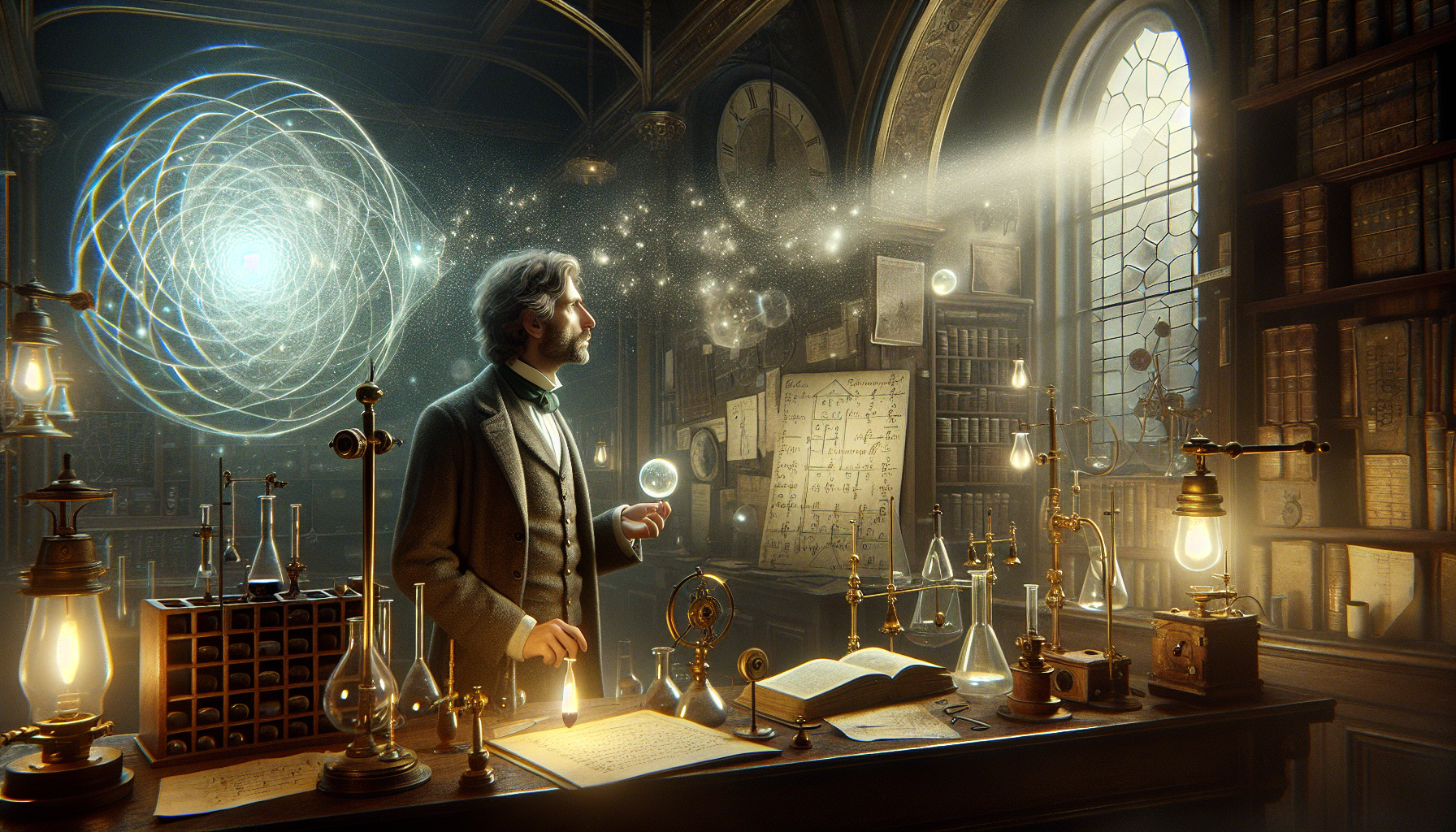In the realm of physics, few concepts have captivated the human imagination as profoundly as the nature of light and its mysterious journey through space. For centuries, scientists and philosophers alike have pondered the medium through which light travels, leading to the once-prevalent theory of the luminiferous ether—a hypothetical substance believed to permeate the universe, serving as the invisible bridge for light’s propagation. As we embark on this exploration, we dive into the captivating world of the luminiferous ether, shedding light on its historical significance, the scientific debates it sparked, and the eventual revelations that reshaped our understanding of the cosmos. 🌌
At the heart of this enigmatic concept lies an essential question: how does light traverse the vast emptiness of space? This question not only spurred curiosity but also laid the groundwork for scientific inquiry that would span centuries. The notion of the luminiferous ether emerged as a solution, suggesting that this invisible medium was crucial for the transmission of light waves. Yet, as history unfolded, this idea faced challenges that would test the very foundation of classical physics. Through a series of groundbreaking experiments and the advent of revolutionary theories, the luminiferous ether was both scrutinized and celebrated, ultimately paving the way for the transformative insights of the 20th century.
Our journey through the ether begins with a glimpse into its historical roots, tracing back to ancient Greek philosophers and the evolution of thought through the Renaissance. We’ll explore the pivotal experiments of the 19th century, such as the Michelson-Morley experiment, which aimed to detect the ether and yielded unexpected results. These findings stirred the scientific community, leading to fervent debates and the gradual unraveling of the ether hypothesis. 📜🔬
The Historical Background of Luminiferous Ether
The concept of the luminiferous ether dates back to ancient Greek philosophy, where thinkers such as Aristotle proposed that the universe was filled with a substance that permeated all things. Fast forward to the 19th century, and this idea evolved into the notion of the ether, a hypothetical invisible medium through which light waves were thought to propagate. This was a time when the nature of light was a profound mystery, sparking intense debate among scientists about whether it was a particle or a wave. As the wave theory gained traction, the need for a medium, akin to air for sound waves, seemed essential for the propagation of light.
During the 19th century, prominent scientists like James Clerk Maxwell contributed significantly to electromagnetic theory, which further strengthened the wave theory of light. Maxwell’s equations, which describe the behavior of electric and magnetic fields, implicitly suggested the existence of a medium—the ether. The ether was envisioned as a stationary, incompressible, and perfectly elastic medium that filled space and served as the stage for electromagnetic waves.
However, the ether was not without its critics. As the century drew to a close, experiments designed to detect the ether, such as the famous Michelson-Morley experiment, consistently failed to provide evidence for its existence. This pivotal experiment attempted to measure the relative motion of Earth through the ether and ended up showing no significant difference in the speed of light, regardless of Earth’s movement. This null result laid the groundwork for new theories that would eventually dismantle the concept of the ether entirely.
Scientific Theories and Experiments Challenging the Ether
As the ether hypothesis faced mounting scrutiny, the scientific community explored alternative explanations for light propagation. Albert Einstein’s theory of special relativity, published in 1905, was groundbreaking in this regard. It proposed that the speed of light is constant in all inertial frames of reference, negating the need for a medium like the ether. This theory elegantly explained the null results of experiments like Michelson-Morley’s and revolutionized our understanding of space and time.
Einstein’s theory suggested that instead of moving through an ether, light travels through a vacuum without the need for any medium. The implications were profound: time and space were no longer absolute, but relative concepts that depend on the observer’s frame of reference. The principles of special relativity have been confirmed by countless experiments and form the basis of modern physics, reshaping our conception of the universe.
Despite its elegance and success, Einstein’s theory did not provide a complete picture of all physical phenomena, particularly at the quantum level. Quantum mechanics emerged as a powerful framework for understanding the behavior of particles at the smallest scales. In the quantum realm, phenomena like wave-particle duality and entanglement defy classical intuition and further challenge the notion of a medium like the ether.
Table: Key Experiments and Their Impact on the Ether Theory
| Experiment | Scientist(s) | Outcome |
|---|---|---|
| Michelson-Morley Experiment | Albert A. Michelson and Edward W. Morley | Failed to detect the ether wind, supporting the constancy of the speed of light. |
| Fizeau Experiment | Hippolyte Fizeau | Measured the speed of light in moving water, challenging the ether drag hypothesis. |
| Hertz’s Experiments | Heinrich Hertz | Demonstrated the existence of electromagnetic waves, supporting Maxwell’s theory. |
Modern Interpretations and the Quantum Perspective
In the contemporary scientific landscape, the concept of the luminiferous ether is regarded as an obsolete idea, replaced by the framework of quantum field theory. Quantum field theory posits that fields, rather than particles or a medium, are the fundamental entities of the universe. In this view, particles are excitations of underlying fields that permeate space, akin to ripples on a pond.
Quantum field theory unifies quantum mechanics and special relativity, providing a comprehensive description of particle interactions. It introduces the notion of virtual particles, which are temporary fluctuations in fields that mediate forces between particles. This perspective aligns with the observed behavior of particles at both macroscopic and microscopic scales, without requiring an ether.
Moreover, the advent of the Higgs field and the discovery of the Higgs boson have further enriched our understanding of the universe. The Higgs field, permeating the entire universe, endows particles with mass through the Higgs mechanism. This field can be thought of as a new kind of ‘ether,’ albeit one that behaves in a fundamentally different way, consistent with quantum theory.
Recommended Video
For a deeper understanding of these concepts, watch the following video: “The Real Meaning of E=mc² – Einstein’s Big Idea” by PBS Space Time. This video explores the principles of relativity and their implications for modern physics.
Impact on Modern Science and Technology
The demise of the ether concept and the rise of relativity and quantum mechanics have had profound effects on modern science and technology. The understanding of light as an electromagnetic wave has led to the development of technologies such as lasers, fiber optics, and wireless communication. These advancements have revolutionized industries ranging from telecommunications to medicine, underpinning the digital age we live in today.
Furthermore, the principles of relativity have been crucial in advancing our understanding of the universe. General relativity, an extension of special relativity, describes gravity not as a force but as a curvature of spacetime caused by mass. This has led to predictions of phenomena such as black holes and gravitational waves, which have been confirmed through astronomical observations and experiments.
Quantum mechanics, with its counterintuitive principles, has paved the way for innovations such as quantum computing and quantum cryptography. These technologies promise to revolutionize computing and data security by harnessing the unique properties of quantum systems. As we continue to explore the quantum realm, we uncover new possibilities and challenges, pushing the boundaries of our understanding and technological capabilities.
Actionable Insights
- Explore further into the quantum realm and its technologies through online courses and lectures.
- Stay updated with recent discoveries in astrophysics and cosmology that test the boundaries of relativity.
- Consider the implications of quantum computing on future technological developments and career opportunities.
The journey from the luminiferous ether to modern physics is a testament to the power of scientific inquiry and the evolution of human understanding. While the ether is now a relic of the past, the quest to unravel the mysteries of the universe continues, driven by curiosity and innovation.

Conclusion
In conclusion, the exploration of the luminiferous ether theory offers a fascinating journey through the history of scientific thought and the quest to understand the propagation of light. This concept, which once stood as a cornerstone of physics, has been both a source of inspiration and a subject of intense debate. Its story is a testament to the ever-evolving nature of scientific inquiry and the relentless pursuit of knowledge.
To recapitulate, the luminiferous ether was postulated as an all-pervading, invisible medium through which light waves were thought to travel. This theory was instrumental in the development of classical wave theory and played a crucial role in shaping our understanding of light propagation during the 19th century. However, the inability to detect this ether through experiments, most notably the Michelson-Morley experiment, led to significant skepticism and eventually the abandonment of the theory. The ether’s downfall was a pivotal moment that paved the way for Albert Einstein’s revolutionary theory of relativity, which fundamentally changed our understanding of space, time, and light.
The discussion of the luminiferous ether highlights several key themes: the progression of scientific theories, the importance of empirical evidence, and the dynamic nature of scientific paradigms. These themes underscore the idea that science is not static but a continually evolving process that builds upon the past to inform the future. The transition from the ether theory to the theory of relativity exemplifies how scientific advancements are often born from challenging existing beliefs and embracing new ideas.
Understanding the historical context and scientific journey surrounding the luminiferous ether provides valuable insights into the nature of scientific discovery. It reminds us that scientific theories are models of understanding that evolve as new evidence emerges and as our ability to measure and comprehend the universe improves. This story of change and adaptation is not just relevant to scientists but to all of us as we navigate a world that is constantly changing.
The exploration of this topic also reinforces the importance of curiosity and open-mindedness in scientific endeavors. Just as the luminiferous ether was once the leading explanation for light propagation, today’s widely accepted theories may one day be challenged and refined. This notion encourages us to remain open to new possibilities and to continuously question and test our understanding of the world.
As we reflect on the journey of the luminiferous ether and its implications, it is crucial to recognize the broader impact of scientific advancements on society. The quest to understand the nature of light has led to numerous technological innovations and has deepened our understanding of the universe. It has inspired generations of scientists and continues to be a driving force in the fields of physics and cosmology.
We encourage readers to delve deeper into the fascinating history of the luminiferous ether and its role in the evolution of scientific thought. Engage with this story, share it with others, and consider its implications for how we perceive and engage with the world. By doing so, you contribute to a broader understanding and appreciation of the scientific process and its impact on our lives.
Let this exploration be a reminder of the power of human curiosity and the endless possibilities that lie ahead. As we continue to explore the mysteries of the universe, may we do so with the same passion and determination that drove the scientists of the past to challenge the status quo and seek the truth.
🌟 We invite you to share your thoughts and insights on this topic. Whether you are a seasoned physicist or a curious mind, your perspective is valuable and adds to the richness of our collective understanding. Comment below, share this article with others who might find it intriguing, and let’s continue the conversation. Together, we can illuminate the path of discovery and understanding.
[For further reading on the history and impact of the luminiferous ether, you can explore resources from reputable sources such as the Stanford Encyclopedia of Philosophy and ].
Toni Santos is a visual storyteller and conceptual archivist whose work explores the curious, often poetic ruins of pseudoscience and obsolete theories. With a reverence for forgotten frameworks and fantastical logic, Toni illuminates the imaginative spaces where science once drifted into myth, speculation, and symbolic belief.
His creative path is rooted in a fascination with the fringe — from phrenology maps to ether diagrams, hollow earth charts to animal magnetism illustrations. Each visual Toni creates or curates is an invitation to reexamine the strange beauty of discarded knowledge — not as failure, but as cultural reflection, as art born from our eternal desire to explain the unexplainable.
Blending visual design with historical inquiry, Toni gives new life to lost diagrams, metaphysical charts, and antique engravings that once shaped worldviews. His work occupies the liminal zone between fact and fiction, where obsolete models still pulse with philosophical resonance and forgotten charm.
As the mind behind Vizovex, Toni shares illustrated essays, curated collections, and visual reinterpretations that invite others to explore the aesthetic and symbolic value of outdated theories. His goal is not to validate, but to remember — to view these speculative systems as relics of human creativity, vulnerability, and yearning.
His work is a tribute to:
The elegance of error in the evolution of knowledge
The symbolic artistry of discarded explanations
The blurred lines between belief, observation, and imagination
Whether you’re a collector of curious ideas, a lover of forgotten diagrams, or someone drawn to the strange scaffolding of old worldviews, Toni opens a portal to a time when the universe was still full of ghosts, humors, and cosmic fluids — one chart, one symbol, one discredited wonder at a time.





